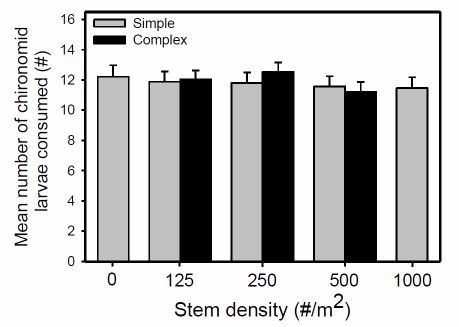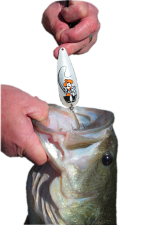Effects of vegetation on largemouth bass recruitment
This page describes four projects that aim to improve our understanding of how vegetation affects recruitement processes of young-of-year largemouth bass. These projects are being conducted by two graduate students (Kris Stahr and Chance Broderius).
Effects of vegetation on the survival and anti-predator behavior of juvenile largemouth bass
Project personnel: Kris Stahr and Dan Shoup
Stahr, K.J.*, and Shoup, D.E. 2015. American water willow mediates survival and antipredator behavior of juvenile largemouth bass. Transactions of the American Fisheries Society. 144:903-910.

State and federal agencies typically introduce aquatic vegetation to increase recruitment of sport fishes, particularly Largemouth Bass (Micropterus salmoides). However, due to frequent turbidity and water-level fluctuations, managers in the southern United States are often left to introduce emergent macrophytes instead of submersed macrophytes. Emergent macrophytes have less underwater structural complexity compared to most submersed macrophytes and therefore may not be as effective in reducing predation risk of Largemouth Bass. Therefore, the objective of this study was to determine if American water willow Justicia americana, a common emergent macrophyte species introduced in reservoirs, increases the survival of juvenile Largemouth Bass when exposed to predation. Predator -prey interactions between 10 juvenile and one adult Largemouth Bass were observed in tanks with natural densities of American water willow and compared with similar trials in vegetation-free control tanks. Each adult Largemouth Bass was tested once in each treatment (vegetation present or absent). Water willow significantly reduced the attack to capture ratio of adult Largemouth Bass, and decreased the amount of time spent searching and the number of captures, resulting in significantly higher survival in vegetated trials. Although water willow provided a similar increase in survival compared with previous studies using submersed macrophytes (i.e., with bluegill prey), the mechanism underlying this change differed, likely resulting from the more rigid stem design of water willow. We conclude water willow is an excellent candidate for establishment in reservoirs because it is easier to establish than many other macrophyte species yet it still reduces predation risk on juvenile Largemouth Bass.

Effects of vegetation on the survival and anti-predator behavior of invertivorous juvenile largemouth bass
Project personnel: Kris Stahr and Dan Shoup
Stahr, K.J.*, and Shoup, D.E. 2016. The effects of macrophyte stem density and structural complexity on foraging return of invertivorous juvenile largemouth bass. North American Journal of Fisheries Management. 36:788-792.

Vegetation is often introduced into reservoirs with the goal of improving recruitment of sportfish, especially largemouth bass. Our previous research demonstrates vegetation in fact does provide a predation refuge for juvenile largemouth bass that improves survival. Previous research with bluegill demonstrated that the increase in survival comes at a cost of less efficient foraging leading to reduced growth, which itself could lead to reduced recruitment if fish cannot grow large enough to successfully overwinter. It is not known if this predation risk / growth tradeoff exists for largemouth bass. This study was designed to investigate the effects of vegetation density and complexity on foraging return of pre-piscivorous largemouth bass. Pre-piscivorous juvenile largemouth bass were tested individually at each of four vegetation densities (0, 100, 250 and 500 stems/m2) of artificial macrophytes (green nylon twine) within 5-gallon aquaria. Complex macrophyte treatments were also created with similar stem density but with a branched stem design (second piece of string cut in half with one half attached to the base and the other to the midsection of an uncut string that serves as the main stem). Thirty frozen bloodworms were used as prey during each15-min foraging bout. Foraging return was similar across all vegetation densities tested and no vegetation density had lower foraging return than the vegetation-less control treatment. Overall, our results suggest aquatic macrophytes may reduce predation risk of juvenile largemouth bass with no negative effects on foraging return.


Simple (left) and complex (right) vegetation treatements used in our experiment. Both aquaria have 500 stems/m2 stem density, but the complex treatement has twice as much string because a second string of the same length was cut in half and used to create two additional "branches" on the main stem.

The effects of vegetation density and complexity on the foraging efficiency of piscivorous juvenile largemouth bass
Project personnel: Chance Broderius, Kris Stahr and Dan Shoup
Previous research from our lab found that vegetation provides a predation refuge that increases survival of juvenile largemouth bass. Vegetation provides a similar predation refuge to bluegill, but comes at the cost of reduced foraging return that can limit recruitment via poor over-winter survival of smaller individuals. We have tested the effects of vegetation on pre-piscivorous largemouth bass foraging return and found vegetation does not hamper foraging return at this life stage. This finding is in contrast to published field studies that correlate dense vegetation with slower growth of largemouth bass, suggesting that that the vegetation either delayed the shift to a piscivorous diet or caused lower foraging return once this shift occurred. Therefore, this study was designed to test the effects of vegetation density and complexity on foraging return of piscivorous juvenile largemouth bass. The study was designed similarly to the pre-piscivorous largemouth bass feeding trial study described above, but with juvenile fathead minnows instead of chironomids as prey. Forty-seven piscivorous young-of-year Largemouth Bass were allowed to individually forage on five Fathead Minnows (Pimephales promelas) in eight treatments of varying simulated vegetation densities (0, 125, 250, 500, and 1,000 stems/m2) and complexities (simple vs complex “simple” design with single stem or “complex” design with branched stem). Piscivorous Largemouth Bass consumed the most piscine prey in the 125 stems/m2 simple treatment and the least in the 0 stems/m2 treatment. All other comparisons were not significantly different. Our results indicate that piscivorous juvenile Largemouth Bass forage most efficientlyhave the greatest foraging success in low vegetation densities and least efficientlylowest success in vegetation absent-free environments and as such managers should strive to provide habitats with moderately low vegetation densities to increase the rate of piscivory in juvenile Largemouth Bass.

Effects of vegetation density on the timing of ontogeny to piscivory of juvenile largemouth bass
Project personnel: Chance Broderius and Dan Shoup

Largemouth Bass (Micropterus salmoides) are an economically important gamefish species in North America and as such are a focal species for managers. A frequent bottleneck to their recruitment is overwinter survival in their first year of life. Early ontogeny to piscivory provides increased overwinter survival through growth and accumulation of lipids. Anecdotal field evidence with juvenile largemouth bassand detailed experiments with a related species (bluegill) suggests dense and complex vegetative habitats could reduce growth, either by reducing foraging return in general or by delaying ontogeny to piscivory. Preliminary laboratory work indicates there is not a decrease in foraging return of juvenile largemouth bass when feeding on juvenile fathead minnows at any vegetation density up to 1,000 stems/m2. Therefore, it is likely the slowed growth observed by previous studies might be caused by a delay in the shift to piscivory. To addres this question, we conducted enclosure experiments for 5 weeks during mid-summer, when that juvenile Largemouth Bass typically transition to piscivory. Thirty-two enclosures (1 m2) were constructed in two 0.10 hectare ponds and treated with four stem densities of simulated vegetation (0, 50, 250, and 500 stems/m2). Vegetation was produced using 3-mm diameter yellow polypropylene rope attached to galvanized poultry netting that was staked into the mud in each enclosure. Two ponds with five replicates of each vegetation density (randomized order within rows) were used. Ponds were filled and allowed several weeks for invertebrates to colonize the enclosures. Three juvenile largemouth bass (30-mm TL) were added to each enclosure along with a natural density of larval bluegill (30 per enclosure). Enclosures were sampled weekly with a frame net that exactly fit the inside dimensions of the enclosure to sample largemouth bass diets via gastric lavage. At this time, larval bluegill population was supplemented as needed to maintain the target density. Largemouth Bass switched to piscivory during the second week in the 0, 50, and 500 stems/m2 treatments but failed to completely switch to piscivory in the 250 stems/m2 treatment. Largemouth Bass also grew less in the 250 stems/m2 treatment. We conclude that vegetation density does affect the foraging rate and subsequent ontogeny to piscivory in juvenile Largemouth Bass. However, the differing results between this experiment and other previously published studies suggests vegetation may have an interactive effect with available prey.


